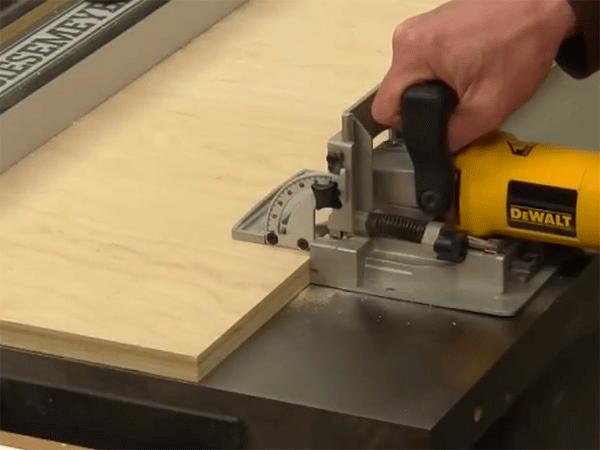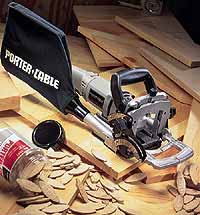
This woodworker wants to know if he can use biscuit joints instead of mortise and tenon joints. The short answer is, of course, it depends. But the larger question is when should woodworkers use biscuits and when does a project call for mortise and tenon? Are there guidelines for making this decision?
Rick White: It all comes down to strength. The biscuit joint doesn’t give you the strength you’ll get with a mortise and tenon. One issue to take into consideration is how the piece is designed and where the stress points will be. As a general rule, however, if I’m building furniture, I use the mortise and tenon. Furniture gets a lot of stress and wear and needs to hold together. For cabinetry, I’ll use a biscuit joint. Most cabinets just hang on the wall and don’t see a lot of stress, so biscuits are usually strong enough.
Ian Kirby: The larger question asks about guidelines for making decisions about the strength of joints.
What we do is make our judgment based on empirical values; we rely on experience and observation. The outcome is that we usually make the joint overly strong. We have no idea by how much it’s overbuilt, but as long as it doesn’t break during its useful life, that’s OK. Mortise and tenon type joints are the ones we use to join parts together to make structures that have to withstand stress ? chairs, beds, tables and the like. Maximizing joint strength seems to me to be a good idea – knowing more about it was what caused me to put forward a proposal for a dissertation whilst studying for my Wood Science and Technology degree. It’s now more years ago than I care to think about, but loosely said, it was a comparison of the strength of mortise and tenon joints and dowel joints.
Well, the proposal got nixed because it was determined to be “insufficiently academic.” Instead I did research on some microscopic comparison between two rare species of softwood – a subject of interest to me and two other people in the world. A couple of years later, FIRA (The Furniture Industry Research Association), a British organization, decided to fund research into what amounted to the same study I had proposed for my first dissertation.
The research was funded for one year – no report. Then it was funded for a second year – no report. Then a third year; the result was “there are altogether too many variables for the data to be of any practical value to a woodworker.” Here is a sampling of the variables:
– How rough or smooth are the walls of the tenon, the mortise and the dowel hole?
– How round is the hole?
– How round is the dowel?
– How tight or loose are the interfaces of the parts?
– What glue was used?
– How thoroughly were the parts wetted with the glue?
– What species of wood was used?
– What was its growth rate?
– Were the joint parts tangential or radial tissue?
– What was the moisture content of the wood?
– And so it remains.
In a mortise and tenon type joint, there are two things to take into account with regards to strength: the mechanical strength and the glue line strength. To get a gauge of the mechanical strength, put the pieces together dry and test the sort of stress it would take to cause them to come apart. In other words, how much does the joint rely on the glue in order to stay together?
To illustrate the point, I’ll briefly describe four of the options you generally have with this sort of joint situation: a traditional MandT, a loose tenon, a dowel joint and a biscuit joint.
Of the four, the traditional M and T is the only two-part joint. The others all bring into play a third element. Since the sizes and sections of the parts vary, each mortise and tenon is designed to be as strength-balanced as possible. The tenon part is no stronger than the mortise part. It’s also designed to have the maximum glue area possible.
A loose tenon has much the same strength as a mortise and tenon. What you begin to realize now is that form doesn’t follow function ? form follows economy. You only need one machine to make a loose tenon: a slot mortiser. The question is: can you afford one?
In spite of all the theoretical disadvantages and failings of a dowel joint, it mostly works.
The biscuit joint has quite a bit less mechanical strength than the other three and its glue area isn’t great. But it scores big on the accuracy of its glue line. The walls of the joint are smooth, the plate swells to form a tight interface and, in many cases, it’s possible to double up the biscuits so the gluing area is doubled.
At the end of the day, whatever you decide, you must ask: Is the joint sufficiently strong to outlast the useful life of the piece?

Rob Johnstone: Mortise and tenon joints can be decorative, but the main reason to use them is to join two pieces of wood in a strong efficient manner. My opinion, and I know it is in the minority, is that biscuit joints are handy for accurately aligning joints and nothing else. I don’t believe an edge that is joined for glue-up is any stronger for having biscuits in it, but it is easier to line the edges of the glue joint up in a hurry. And if you are edge gluing five or six boards, biscuits are a real time-saver. So if the mortise and tenon joint is inteded to aid in alignment of a piece rather than creating a strong joint, I say go ahead and biscuit away. If you’re asking if the biscuit joint would be stronger or superior in any other way, I say no.
Ellis Walentine: Yes and no, depending on the type and severity of the stresses you expect. Technically, a biscuit joint is a type of mortise-and-tenon joint ? where one piece of wood penetrates and is glued into another. Both types of joints keep parts aligned and offer resistance to twisting, shearing, levering and pullout forces on the assembly. The strength of every type of mortise-and-tenon joint depends on several things.
1. The type of wood determines the mechanical strength of the joint: harder, stiffer woods are more resistant to breaking.
2. The design of the joint is also important. It involves the proportions of the mortise, the tenon and the “shoulders” where the two parts actually meet.
3. But, for practical purposes, the glue area is what really holds the joint together. Biscuits don’t offer as much glue area as traditional tenons, so you need more biscuits to equal the pullout and levering strength of a tenon. On the other hand, biscuits generally provide enough glue surface to keep the shoulders tight, which makes the joint just as solid. Biscuits are best suited for plywood case construction, for which they were originally designed. They also are fine for long edge joints, some cabinet doors and other types of frames, including those with mitered corners. Properly designed biscuit joints ? often involving multiple, ganged or stacked biscuits – have also been used for demanding tasks such as full-size doors.
Personally, I prefer the security of deep, accurately machined tenons for heavier-duty applications where greater mechanical strength may be needed.





